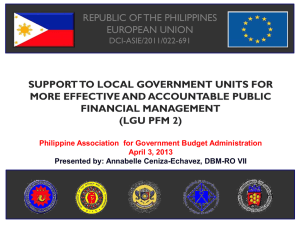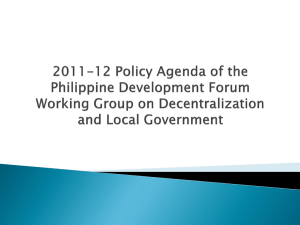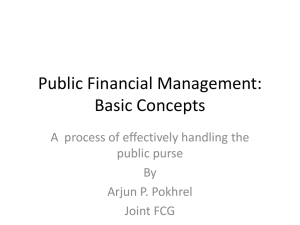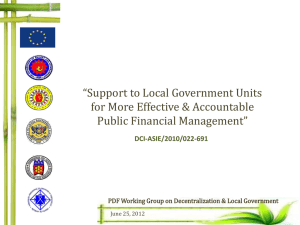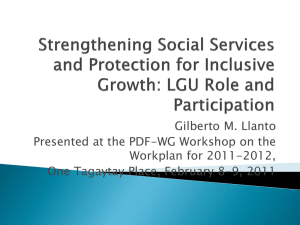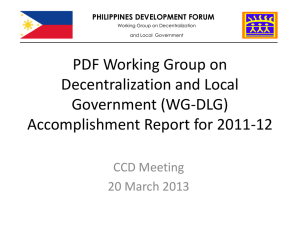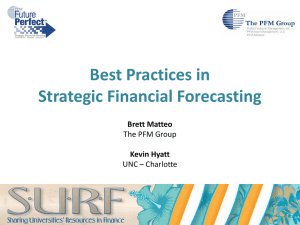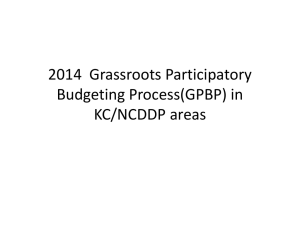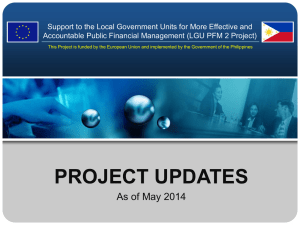Financial Mgnt and Accountability for Sustainable Local Governance
advertisement
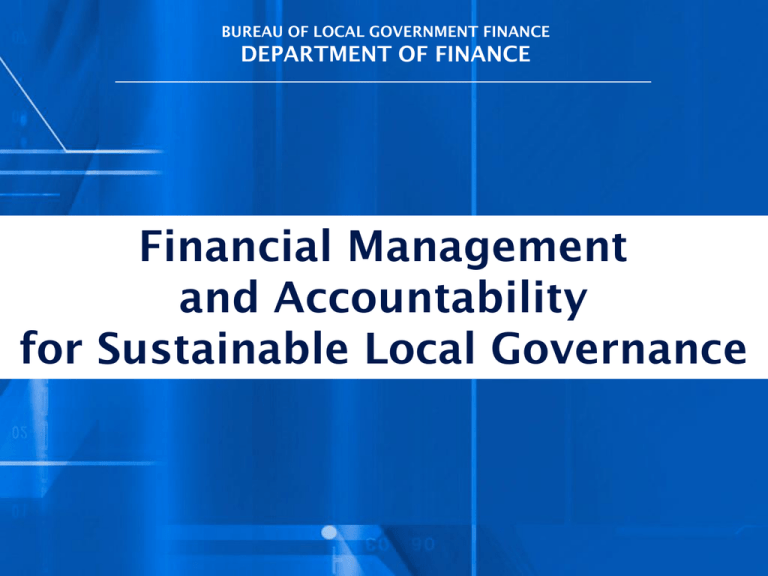
BUREAU OF LOCAL GOVERNMENT FINANCE DEPARTMENT OF FINANCE Financial Management and Accountability for Sustainable Local Governance PUBLIC FINANCIAL MANAGEMENT The Framework Public Reporting on Financial Operations Auditing Revenue Generation Effective and Accountable PFM Budgeting (Expenditure Management +Procurement) Cash Management Accounting Debt Management PLAN PUBLIC FINANCIAL MANAGEMENT The Framework Public Reporting on Financial Operations Auditing Revenue Generation PFM Effective and Accountable PFM Budgeting (Expenditure Management) Cash Management Accounting Debt Management PLAN 1. THE LGU PFM REFORM ROADMAP 2. THE PFM REFORM IMPLEMENTATION STRATEGY Outline of Presentation 2 Ws and 1 H of the LGU PFM Reform Roadmap Why, What and How…. LGU PFM Reform Implementation Strategy Why develop the LGU PFM Reform Roadmap? BASIC CONSIDERATIONS: 1. CAPACITY TO HANDLE FUNDS 2. CAPABILITY TO IMPLEMENT PROJECTS 3. OPERATIONAL ACCOUNTABILITY MECHANISMS Why develop the LGU PFM Reform Roadmap? Need for a Single and Comprehensive Guide to address Weak PFM Effective and Accountable Public Financial Management o Lack of fiscal sustainability and poor expenditure management o Inadequate accountability mechanisms o Weak coordination among Oversight Agencies (OAs) and between OAs and LGUs What is the LGU PFM Reform Roadmap? o A strategic guide on what we (LGUs) want to do and achieve with our PFM in the immediate, medium and long term periods to attain our desired end-state (goal) o complemented by a well-designed action program that details the activities and timeframe on how and when we could reach our PFM goal and vision. Impact of the Roadmap o Provide LGUs with strategic directions to strengthen their PFM system towards improved revenue generation and expenditure management Two very crucial systems in the efficient and effective delivery of services! Impact of the Roadmap o Assist the OAs to strengthen their coordination in better supporting PFM reforms identified, designed and being implemented by the LGUs o Guide Development Partners in identifying possible entry points for financial support and other interventions How was the LGU PFM Reform Roadmap developed? established the current state of LGU PFM system identified the desired end-state of the said system laid down the policy agenda that will help both LGUs and Oversight Agencies (OAs) in getting to the desired end-state How was the LGU PFM Reform Roadmap developed? Current State Established Baseline Information • Rapid Assessment prepared by the Technical Assistance Team • PFMAT results of 550 FY 2013 Grassroots Participatory Budgeting Process (Bottom-up Budgeting) focus LGUs How was the LGU PFM Reform Roadmap developed? Current State Established Baseline Information • Rapid Assessment prepared by the Technical Assistance Team • PFMAT results of 550 FY 2013 Grassroots Took stock of the current directions and Participatory Budgeting Process (Bottom-up initiatives undertaken by government and Budgeting) focus LGUs development partners SUPPORT TO THE LOCAL GOVERNMENT UNITS FOR MORE EFFECTIVE AND ACCOUNTABLE PUBLIC FINANCIAL MANAGEMENT (LGU PFM 2 PROJECT) How was the LGU PFM Reform Roadmap developed? Current State Established Baseline Information • Rapid Assessment prepared by the Technical PFMAT is a self-assessment, evidence-based instrument whichTeam describes the characteristics of an open and orderly Assistance PFM system. It is a diagnostic tool which will help LGUs identify the strengths and weaknesses of their PFM system as basis for improvement measures. • PFMAT results of 550 FY 2013 Grassroots Participatory Budgeting Process (Bottom-up Budgeting) focus LGUs SUPPORT TO THE LOCAL GOVERNMENT UNITS FOR MORE EFFECTIVE AND ACCOUNTABLE PUBLIC FINANCIAL MANAGEMENT (LGU PFM 2 PROJECT) PFMAT Results o FY 2013 Bottom-up Budgeting (BuB) focus LGUs earned a total mean rating of 2.34 o Indicates that elements of an open and orderly PFM system are not complete but what exist are already fully operational SUPPORT TO THE LOCAL GOVERNMENT UNITS FOR MORE EFFECTIVE AND ACCOUNTABLE PUBLIC FINANCIAL MANAGEMENT (LGU PFM 2 PROJECT) PFMAT Results o Lowest ratings indicate the elements not yet in place: » Internal and External Audit » Policy-based Budgeting » Accounting, Recording and Reporting SUPPORT TO THE LOCAL GOVERNMENT UNITS FOR MORE EFFECTIVE AND ACCOUNTABLE PUBLIC FINANCIAL MANAGEMENT (LGU PFM 2 PROJECT) PFMAT Results INTERNAL & EXTERNAL AUDIT • Most LGUs do not have Internal Audit Service (IAS) Units • No internal audit reports which are prepared for management to act upon • Settlement of disallowances and compliance with audit recommendations by the LGUs are low SUPPORT TO THE LOCAL GOVERNMENT UNITS FOR MORE EFFECTIVE AND ACCOUNTABLE PUBLIC FINANCIAL MANAGEMENT (LGU PFM 2 PROJECT) PFMAT Results POLICY-BASED BUDGETING • Strong link between AIP and Budget but weak linkage among development plans (PDPFP/CDP-LDIP-AIP) • CDP not prepared by most LGUs • LEEs not financially self-reliant • Only 1 to 2 PFM Improvement Policies included in the Budgets SUPPORT TO THE LOCAL GOVERNMENT UNITS FOR MORE EFFECTIVE AND ACCOUNTABLE PUBLIC FINANCIAL MANAGEMENT (LGU PFM 2 PROJECT) PFMAT Results ACCOUNTING, RECORDING & REPORTING • LGUs are not able to fully comply with the reglementary periods for reconciling bank accounts and liquidating cash advances SUPPORT TO THE LOCAL GOVERNMENT UNITS FOR MORE EFFECTIVE AND ACCOUNTABLE PUBLIC FINANCIAL MANAGEMENT (LGU PFM 2 PROJECT) How was the LGU PFM Reform Roadmap developed? Current State Current Issues in PFM identified and validated by Stakeholders (OAs and LGUs) • Rapid Assessment prepared by the Technical Assistance Team • PFMAT results of 550 FY 2013 Grassroots Participatory Budgeting Process (Bottom-up Budgeting) focus LGUs • Consultation Workshops with stakeholders Validated in nationwide Consultation Workshops with OAs and LGUs (October 2013 – March SUPPORT2014) TO THE LOCAL GOVERNMENT UNITS FOR MORE EFFECTIVE AND ACCOUNTABLE PUBLIC FINANCIAL MANAGEMENT (LGU PFM 2 PROJECT) Validation of PFMAT Results POLICY-BASED BUDGETING PFMAT RESULTS • Strong link between AIP and Budget but weak linkage among development plans (PDPFP/CDPLDIP-AIP) • LEEs not financially self-reliant • Only 1 to 2 PFM Improvement Policies included in the Budgets VOICE OF THE STAKEHOLDERS • Weak alignment between Development Plans & Budget • Lack of long-term planning perspective • Lack of alignment between PPAs and policies and current issues • Weak LEEs • There are bottlenecks in the budgeting process SUPPORT TO THE LOCAL GOVERNMENT UNITS FOR MORE EFFECTIVE AND ACCOUNTABLE PUBLIC FINANCIAL MANAGEMENT (LGU PFM 2 PROJECT) Participants to the Consultations: REGION NO. OF LGUs NO. OF PAX REGION NO. OF LGUs NO. OF PAX CAR 7 9 6 10 13 NCR 5 8 7 5 5 1 6 6 8 4 4 2 6 9 9 5 6 3 4 6 10 3 3 4A 5 5 11 12 16 4B 4 4 12 6 9 5 5 6 13 6 6 SUPPORT TO THE LOCAL GOVERNMENT UNITS FOR MORE EFFECTIVE AND ACCOUNTABLE PUBLIC FINANCIAL MANAGEMENT (LGU PFM 2 PROJECT) Participants to the Consultations: REGION NO. OF LGUs NO. OF PAX REGION NO. OF LGUs NO. OF PAX CAR 7 9 6 10 13 NCR 5 8 7 5 5 1 6 6 8 4 4 2 6 9 9 5 6 3 4 6 10 3 3 4A 5 5 TOTAL LGUS 11 12 = 93 4B 4 4 12 6 9 TOTAL PARTICIPANTS = 115 5 5 6 13 6 SUPPORT TO THE LOCAL GOVERNMENT UNITS FOR MORE EFFECTIVE AND ACCOUNTABLE PUBLIC FINANCIAL MANAGEMENT (LGU PFM 2 PROJECT) 16 6 Participants to the Consultations: •18 PROVINCES •31 CITIES •44 MUNICIPALITIES SUPPORT TO THE LOCAL GOVERNMENT UNITS FOR MORE EFFECTIVE AND ACCOUNTABLE PUBLIC FINANCIAL MANAGEMENT (LGU PFM 2 PROJECT) How was the LGU PFM Reform Roadmap developed? Desired End-State Determined by Stakeholders (OAs & LGUs) STAKEHOLDERS’ VOICE • Strong linkage of long term plans with Annual Budget • Budget requirements understood by all and stirs public involvement in the budget process • Sufficient funds for programs and projects anchored on long term plans • Self-reliant LGUs that generate sufficient local revenues to support budget expenditures • Simplified financial systems that yield timely, accurate and credible financial information • Functional and operational Internal Audit Service which leads to zero COA disallowances • Quality participation of CSOs in the planning and budgeting process GOAL “An open and transparent LGU PFM System that is stable and sustainable, renders financial compliance, underpins efficient and effective delivery of services, ensures the highest level of accountability and provides genuine citizens’ participation.” VISION “An LGU service delivery system that lowers the cost of doing business, stimulates private investments, generates employment and income opportunities, improves welfare levels for LGU constituents and accelerates local economic growth.” SUPPORT TO THE LOCAL GOVERNMENT UNITS FOR MORE EFFECTIVE AND ACCOUNTABLE PUBLIC FINANCIAL MANAGEMENT (LGU PFM 2 PROJECT) How was the LGU PFM Reform Roadmap developed? Issue and Determined by Stakeholders (OAs and Policy Agenda LGUs) ISSUE Link between PDPFP / CDP – LDIP – AIP and Budget POLICY AGENDA Strengthen the linkage between PDPFP/ CDP – LDIP – AIP and Budget SUPPORT TO THE LOCAL GOVERNMENT UNITS FOR MORE EFFECTIVE AND ACCOUNTABLE PUBLIC FINANCIAL MANAGEMENT (LGU PFM 2 PROJECT) SUPPORT TO THE LOCAL GOVERNMENT UNITS FOR MORE EFFECTIVE AND ACCOUNTABLE PUBLIC FINANCIAL MANAGEMENT (LGU PFM 2 PROJECT) This project is funded by the European Union and implemented by the Government of the Philippines The LGU PFM REFORM IMPLEMENTATION ROADMAP STRATEGY The LGU PFM Reform Implementation Strategy Operationalizes the LGU PFM Reform Roadmap Lays down the specific actions to be done to carry out the policy agenda that will result to the outcomes Anticipates the implementation risks and identifies mitigating measures SUPPORT TO THE LOCAL GOVERNMENT UNITS FOR MORE EFFECTIVE AND ACCOUNTABLE PUBLIC FINANCIAL MANAGEMENT (LGU PFM 2 PROJECT) The LGU PFM Reform Implementation Strategy Matrix Issue Link between PDPFP/ CDP – LDIP – AIP and Budget Policy Agenda Implementation Implementation Strategy Strategy (OAs) (LGUs) Strengthen Linkage between PDPFP/ CDP – LDIP – AIP and Budget Enhance CDP / LDIP Manual Issue policy reiterating compliance with Enhanced CDP Manual Outcomes Risks Mitigation 2016 All LGUs fully capacitated to prepare CDPs with matching LDIPs from which AIPs are derived Capacity of ROs’ technical personnel to provide TA to LGUs SUPPORT TO THE LOCAL GOVERNMENT UNITS FOR MORE EFFECTIVE AND ACCOUNTABLE PUBLIC FINANCIAL MANAGEMENT (LGU PFM 2 PROJECT) CapDev for ROs on PFM tools Immediate Outputs from the Oversight Agencies 1. Enhanced Joint Memorandum Circular No. 1 on the Harmonization of Local Planning, Investment Programming, Revenue Administration, Budgeting and Expenditure Management 2. Enhanced Public Financial Management Assessment Tool for LGUs and Software 3. Enhanced CDP/LDIP Manual 4. Guidebook on Local Economic Enterprises 5. Enhanced Full Disclosure Policy 6. Standard Revenue and Expenditure, Cash Flow Forecasting Tools SUPPORT TO THE LOCAL GOVERNMENT UNITS FOR MORE EFFECTIVE AND ACCOUNTABLE PUBLIC FINANCIAL MANAGEMENT (LGU PFM 2 PROJECT) Immediate Outputs from the Oversight Agencies 7. Recommendations on the Amendment of the Local Government Code 8. Enhanced Revenue Generation Manuals (LTOM, MELTO, AEEM) 9. Harmonized Policy on CSO accreditation and Handbook on CSO Participation in the Budget Process 10. Harmonized Financial Reports and Templates 11. Localized Internal Audit Manual 12. Revised Budget Operations Manual for LGUs SUPPORT TO THE LOCAL GOVERNMENT UNITS FOR MORE EFFECTIVE AND ACCOUNTABLE PUBLIC FINANCIAL MANAGEMENT (LGU PFM 2 PROJECT) Core Approaches to Implementation of PFM Reforms 1. Multiply sponsorship in the implementation of the LGU PFM Reform Expand the engagement of all stakeholders in the implementation of LGU PFM Reforms to ensure attainment of: • Improved Capacities of OAs and LGUs • Improved LGU PFM systems • Improved service delivery by LGUs SUPPORT TO THE LOCAL GOVERNMENT UNITS FOR MORE EFFECTIVE AND ACCOUNTABLE PUBLIC FINANCIAL MANAGEMENT (LGU PFM 2 PROJECT) Proposed Structure Transition Set-up LGU PFM Reform Roadmap Project Steering Committee National Inter-Agency Team High-level representatives of OAs supported by PTWG High-level representatives of OAs supported by TWG from LGU Policy Units of OAs Regional Inter-Agency Teams Regional Inter-Agency Teams RIAT supported by Composite PFM Team Supported by Composite PFM Team LGU PFM Teams LGU PFM Teams SUPPORT TO THE LOCAL GOVERNMENT UNITS FOR MORE EFFECTIVE AND ACCOUNTABLE PUBLIC FINANCIAL MANAGEMENT (LGU PFM 2 PROJECT) Core Approaches to Implementation of PFM Reforms 2. Empower LGUs to customize their PFM Improvement Plan (PFMIP) LGU stakeholders and sponsors will be enabled to assess their PFM system, design and actualize their PFMIPs based on their own level of readiness SUPPORT TO THE LOCAL GOVERNMENT UNITS FOR MORE EFFECTIVE AND ACCOUNTABLE PUBLIC FINANCIAL MANAGEMENT (LGU PFM 2 PROJECT) Core Approaches to Implementation of PFM Reforms 3. Harmonize and coordinate Oversight Agencies’ technical support to LGUs LGU PFM Reforms seeks to institutionalize convergence of the OAs in providing technical assistance to LGUs SUPPORT TO THE LOCAL GOVERNMENT UNITS FOR MORE EFFECTIVE AND ACCOUNTABLE PUBLIC FINANCIAL MANAGEMENT (LGU PFM 2 PROJECT) Core Approaches to Implementation of PFM Reforms 4. Capacitate Oversight Agencies and LGUs to Manage the Reform OA and LGU Stakeholders and Sponsors/Champions will be capacitated on change management SUPPORT TO THE LOCAL GOVERNMENT UNITS FOR MORE EFFECTIVE AND ACCOUNTABLE PUBLIC FINANCIAL MANAGEMENT (LGU PFM 2 PROJECT) SUPPORT TO THE LOCAL GOVERNMENT UNITS FOR MORE EFFECTIVE AND ACCOUNTABLE PUBLIC FINANCIAL MANAGEMENT (LGU PFM 2 PROJECT) This project is funded by the European Union and implemented by the Government of the Philippines WHAT IS THE CONNECTION AMONG THE ROADMAP, IMPLEMENTATION STRATEGY AND PFMIP? The Roadmap, Implementation Strategy & PFMIP Roadmap Implementation Strategy A strategic guide on Lays down the what we (LGUs) want to do and achieve with specific actions to be done to carry out the our PFM in the Details the specific policy agenda that immediate, medium activities which the will result to the and long term periods LGU will undertake to outcomes, and to attain our desired strengthen its PFM anticipates the end-state (vision) System over a given implementation risks period of time and identifies together with the mitigating measures resources needed to carry them out PFMIP Prepared jointly by LGUs and OAs to serve as their overall strategic guide Prepared by LGUs to implement PFM reforms SUPPORT TO THE LOCAL GOVERNMENT UNITS FOR MORE EFFECTIVE AND ACCOUNTABLE PUBLIC FINANCIAL MANAGEMENT (LGU PFM 2 PROJECT) The LGU PFM Reform Roadmap Issues to be Addressed (1) Policy Agenda (2) Link between PDPFP/CDP – LDIP – AIP and Budget Strengthen the linkage between PDPFP/CDP – LDIP – AIP and Budget Outcomes (3) 2016 2019 2022 All LGUs capacitated to prepare and update their CDPs and matching LDIPs from which AIP is culled LGUs prepare and update their CDPs and matching LDIPs from which AIP is culled Strong linkage between PDPFP/ CDP LDIP-AIP and Budget ensured Indicators (4) 2016 ·Proportion of LGUs with enacted or draft PDPFPs/CD Ps and LDIPs prepared and harmonized according with DILG/NEDA Guidelines SUPPORT TO THE LOCAL GOVERNMENT UNITS FOR MORE EFFECTIVE AND ACCOUNTABLE PUBLIC FINANCIAL MANAGEMENT (LGU PFM 2 PROJECT) Responsible Units (5) DILG NEDA DBM BLGF LGUs The Implementation Strategy Issues to be Addressed (1) Link between PDPFP/ CDP – LDIP – AIP and Budget Policy Agenda (2) Strengthen the linkage between PDPFP/ CDP –LDIP – AIP and Budget Implementation Strategies (3) OAs LGUs Enhance Issue policy CDP/LDIP reiterating compliance Manual with including updated incorpora CDP / LDIP -tion of Manual GPBP principles and alignment with PDPFP / PDIP at provincial level Outcomes (4) 2016 2019 All LGUs capacitated to prepare and update their CDPs and matching LDIPs from which AIP is culled 2022 Strong LGUs linkage prepare between and PDPFP/ update CDP their CDPs LDIP-AIP and and matching Budget LDIPs ensured from which AIP is culled Risk Register (5) Risks Capacity of ROs’ technical personnel to provide TA to LGUs SUPPORT TO THE LOCAL GOVERNMENT UNITS FOR MORE EFFECTIVE AND ACCOUNTABLE PUBLIC FINANCIAL MANAGEMENT (LGU PFM 2 PROJECT) Mitigation CapDev for ROs on PFM tools The PFM Improvement Plan (PFMIP) LGU: Municipality of San Julian For Fiscal Year 2015 Issues to be Addressed (1) Policy Agenda (2) Strengthen Link the linkage between between PDPFP / PDPFP/ CDP – LDIP – AIP CDP –LDIP – AIP and and Budget Budget Implementation Strategies (3) Issue policy reiterating compliance with updated CDP / LDIP Manual Activities (4) Outputs (5) Conduct orientation on the updated CDP / LDIP Manual Issue Executive Order / Sanggunian Resolution Executive Order / Sanggunian Resolution Responsible Unit (6) Schedule (7) Budget (8) LPDO January 2015 P20,000.00 LCE / Sanggunian February 2015 SUPPORT TO THE LOCAL GOVERNMENT UNITS FOR MORE EFFECTIVE AND ACCOUNTABLE PUBLIC FINANCIAL MANAGEMENT (LGU PFM 2 PROJECT) Prioritizing the Specific Activities for the PFMIP Categorize Tasks Identify what is most feasible and have the highest value in terms of visible impact in the shortest time • In what order do actions need to be taken • What are the interdependencies in our activities? • What is the local capacity to absorb change? SUPPORT TO THE LOCAL GOVERNMENT UNITS FOR MORE EFFECTIVE AND ACCOUNTABLE PUBLIC FINANCIAL MANAGEMENT (LGU PFM 2 PROJECT) Prioritizing the Specific Activities for the PFMIP Balance Technical with Tactical Considerations: • Technical Aspects – what needs to be done to improve PFM “What is technically most important may not be tactically feasible.” • Resources – personnel, financial and other logistics • Political Demand – what is wanted and can be supported by key stakeholders (LCE & Local Sanggunian) SUPPORT TO THE LOCAL GOVERNMENT UNITS FOR MORE EFFECTIVE AND ACCOUNTABLE PUBLIC FINANCIAL MANAGEMENT (LGU PFM 2 PROJECT) FY2009 FY2010 FY2011 Ano’ng Iskor ng ‘yong Bayan? FY2012 LGU FISCAL SUSTAINABILITY SCORECARD Financial Management Performance Review for Local Government Units Declining, <1% locally sourced income to GDP 0.91% 0.89% 0.86% 0.80% 2009 2010 2011 2012 Perspective “Supervision of revenue operations of all LGUs” “Monitor and support the implementation of policies and measures on local revenue administration” Assessment of fiscal indicators necessary for exercise of mandate Agency has to have a systematic, not sporadic, process for regular assessment of fiscal performance of LGUs Directive s Protection of revenue integrity, data analytics and metrics Closer, thorough monitoring of revenue performance of LGUs Evidence- and policy-based performance assessment of local treasurers and assessors General housekeeping of reports Visit in BIR revenue regions / BOC ports /LGUs of the Secretary of Finance DOF Department Order No. 08-2011: Statement of Receipts and Expenditures Treasurer: eSRE System in the LGUs Assessor: Quarterly Reports on Real Property Assessments LGU Fiscal Performance Monitoring System BLGF’s Local Revenue Targets SMV Profile and Ordinances of LGUs Basis for Evaluation Local Government Unit FISCAL SUSTAINABILITY SCORECARD Directive of the Secretary Baselining the LGU performance from FY2009 to FY2012 Validating the LGU data and testing the integrity of BLGF reports Compliance monitoring on DOF directives and other relevant regulations Publication of LGU performance Policy setting purposes Indicators Pass Financial (Quantitative) - 90% KRA 1 - Revenue Generation Capacity KRA 2 - Local Collection Growth Fail KRA 3 - Expenditure Management Non-Financial (Qualitative) - 10% 100% KRA 4 - 6 - Reportorial Compliance Financial Indicators KRA 1. Revenue Generation Capacity Indicator 1.1 Regular income level 1.2 Local revenue level 1.3 Local revenue growth (tax and non-tax revenues) 1.4 Dependence on locally sourced income 1.5 Dependence on IRA 1.6 Dep. on Other Shares from National Tax Collection Financial Indicators KRA 3. Expenditure Management Indicator 3.1 Expenditure Per Capita 3.2 Use of IRA for Local Devt. Project (>=20% of IRA) 3.3 Limitation on Expenditure for PS (<=45%/55% of Regular Income of the Next Preceding Fiscal Year) 3.4 Limitation on Debt Service (<=20% of IRA) Focusing on Actual Utilization, not Budget Appropriation Statutory Obligations and Limitations Non-Financial Indicators KRA 4. eSRE Indicator Submission of Timely and Accurate eSRE 7 out of 10 Treasurers Did Not Submit SRE on Time Non-Financial Indicators KRA 5. SMV Updating Indicator Regular Updating of SMV and Conduct of General Revision of Property Assessments 15 Cities & Provinces have new SMVs effective 2014 But 130+ More Are Already DUE… Non-Financial Indicators KRA 6. Quarterly Report on Real Property Assessments (QRRPA) Indicator Submission of Timely and Accurate QRRPA Is the assessor correctly accomplishing the QRRPA? Are there properties with restrictions? Is the land area correct? Final Rating KRA Quantitative Max Score 90 1. Revenue Generation Capacity 60 2. Local Collection Growth 20 3. Expenditure Management 10 Qualitative 10 4. Timely & Accurate eSRE Report 4 5. Current & Updated SMV 3 6. Timely & Accurate QRRPA 3 Final Rating Weighted Score Grad e Rating >=80 A Excellent >=70 but <80 >=60 but <70 >=50 but <60 >=40 but <50 <40 B C Very Good Good Remarks All revenue and expenditure indicators are strong; full compliance with reportorial requirements Most of the revenue and expenditure indicators are met very satisfactorily; high compliance with reportorial requirements Most of the revenue and expenditure indicators are above average performance; minimum level of compliance with reportorial requirements D Average Revenue and expenditure indicators have not significantly changed and are generally on the average; minimum level of compliance with reportorial requirements E Needs Improvement Almost all of the key revenue and expenditure indicators need to be improved and validated; minimum reportorial requirements are not complied with Poor All revenue and expenditure indicators are way below the benchmarks; key reportorial requirements are incomplete/not submitted and/or require further validation F Methodology Utilized the BLGF SRE of all provinces, cities, and municipalities, and the QRRPA of provinces and cities from FY2009-FY2012 Run date of SRE: 15 August 2013 Processed individual SRE fields per LGU (initially cities and provinces) through pivot tables Benchmarking and national comparison through DOF income classification as of 2008 One-on-one data- and process- validation with LGUs and BLGF regions Sample Preliminary Scorecard xxx Sample Preliminary Scorecard RPT Collection Efficiency & YoY Collection Performance VISIT ISKOR.BLGF.GOV.PH In the pipeline… Linking of Scorecards with “Open Data Initiative” Credit rating for LGUs will be next Continuous monitoring and improvement of SRE’s integrity Municipal scorecards release by early June Regional BLGF staff to be trained on LGU FSS Ano’ng Iskor ng ‘yong Bayan? THANK YOU!
